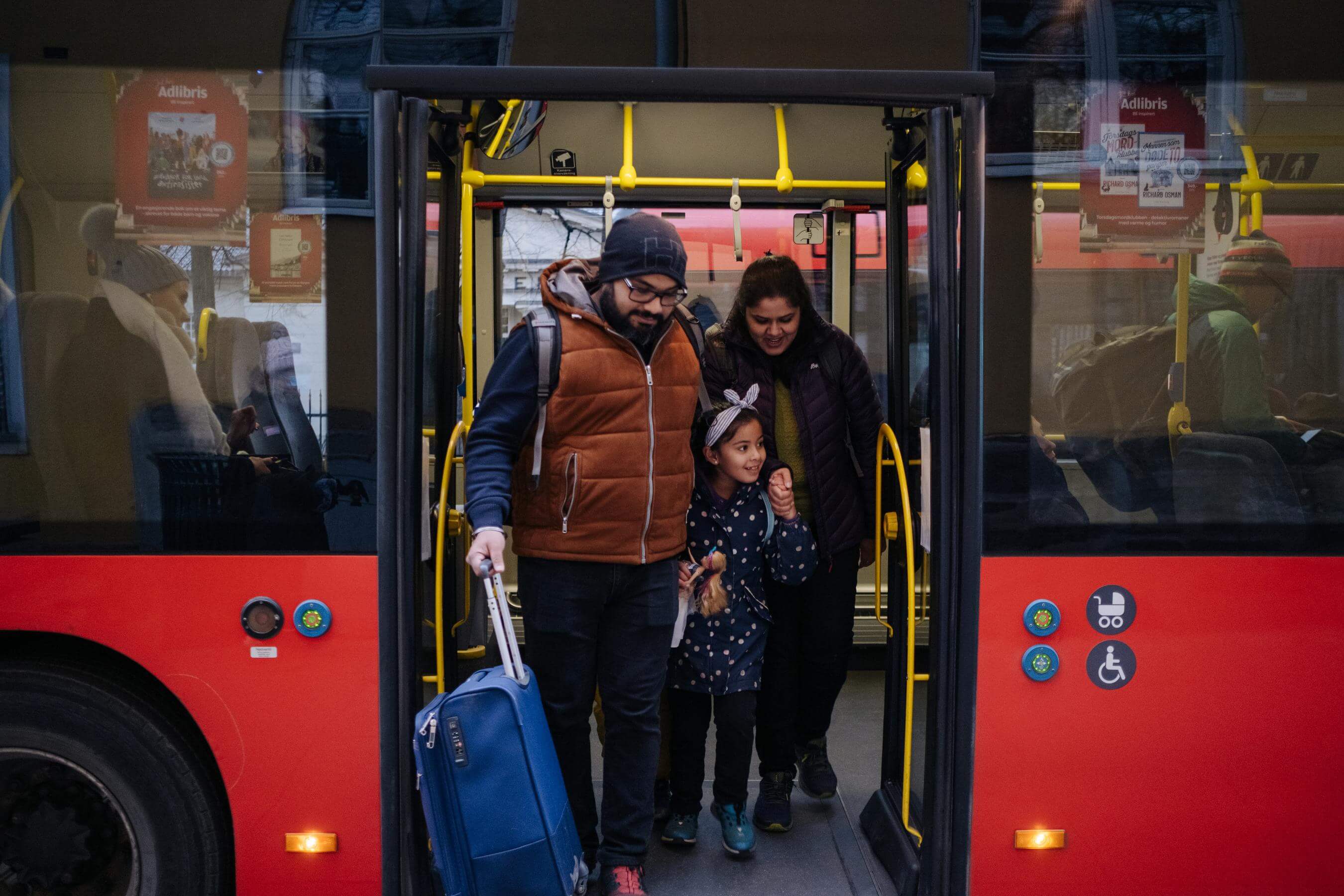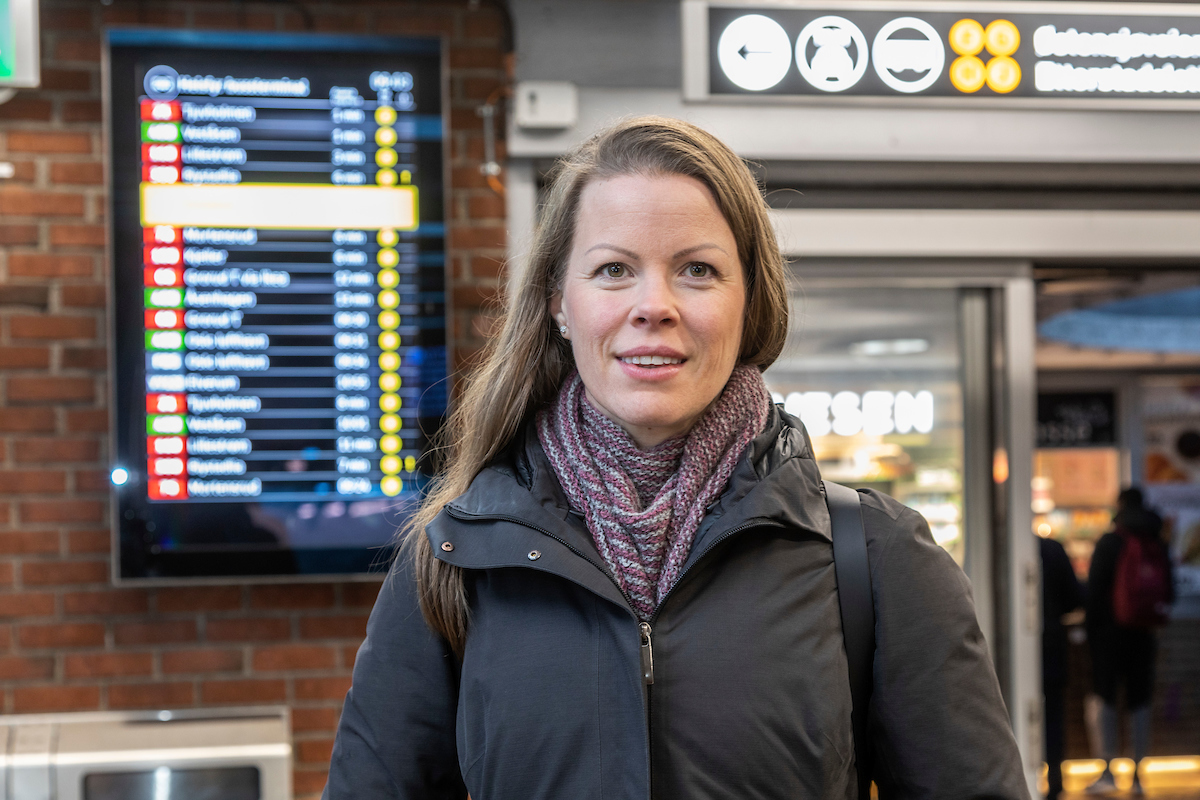
Public transport is for everyone
Ruter cannot have a situation in which disabled people opt out of travelling by public transport because they face too many obstacles. That is why we need to change. We have to be able to offer sustainable freedom of movement – to everyone.
From 2021, increased freedom of movement for the disabled will be one of Ruter’s most important strategic priorities.
In 2020, Bernt Reitan Jenssen, CEO of Ruter, met a young man who left a great impression on him. In a debate on Norwegian television, Amir Hashani stated that as a wheelchair user he often had to give up on travelling by bus – because the bus ramp had got stuck or because the ramp key was missing.
The meeting made Ruter look at things from a new perspective. Hashani was clear that the problems he faced were bigger than the fact that he, a wheelchair user, was not able to get from A to B. It was the issue that exclusion from public transport also in practice means exclusion from participating in society.
For Ruter, this issue is also about our contribution to achieving the UN’s Sustainable Development Goal no. 10: Reduced Inequalities. We know that equal access to transport helps to even out differences in society. This means that everyone should be able to travel to work and school, meet friends and participate in leisure activities on an equal footing.
Ruter has always ensured that as many people as possible could get to where they needed to go – in an efficient and environmentally friendly way. From that point of view, we have succeeded. But we are now expanding our remit: we need to create services that work for everyone, irrespective of ability level, gender, age, ethnicity, religion or budget.
We still have a long way to go and, rather than patch up the system, we need to take a more holistic approach to ensure that fewer people feel excluded.
“Being able to take care of myself, being able to travel alone, means everything to me.”
Former Deputy Director Amir Hashani, Youth Section, Norwegian Association for the Disabled
Fundamental change
A more comprehensive remit requires a new and broader approach: the most important changes are always psychological. We need to work on our culture, awareness and internal processes – as well as technology and physical solutions.
- Incorporating ‘everyone’ into everything we do has to be a matter of course – both at Ruter and in the rest of the public transport system.
- We have to view diversity as a strength and a fantastic starting point for innovation.
- We have to become even better at taking advice from those who feel excluded.
- We have to adjust our own work processes and bring this insight into all our development projects – from the outset.
In 2020, Ruter launched a major, internal project, in collaboration with the Norwegian Association of the Disabled, called Sustainable Freedom of Movement for All.
Good for everyone
Disabled people make up a large group – about 18% of the population according to Bufdir. They often face challenges when travelling by public transport which is why Ruter in 2021 made it a priority to ensure increased freedom of movement for the disabled in particular.
But we believe that what is needed for the disabled can be applied to many more customers at different times of their lives.
For example, a wheelchair user and a customer with a pram face the same obstacles, while the elderly experience many of the same challenges as visually impaired people.
Ultimately, it is not a matter of finding special solutions for the few, but solutions that work for everyone – throughout life.

“Being able to travel on public transport is crucial. If you can’t, you become isolated and lonely.”
Jørund Schwach, active in Mental Helse
Insight into obstacles
The Sustainable Freedom of Movement for All project started with extensive collection of data in 2020 and 2021 to identify the obstacles disabled people encounter on Ruter’s public transport services.
We conducted in-depth interviews with interest groups and people with a range of disabilities.
We also interviewed drivers, operations managers and other applicable staff with our operators and partners to find out what changes we needed to make in order to give disabled people an enhanced travel experience.
Main findings
Independence: The disabled want to be able to travel independently, without having to depend on others.
Safety: Many experience stress and have to expend a great deal of energy before and during travel because they do not get the information they need in order to travel safely.
Participation: Being prevented from taking public transport excludes many from important social activity such as learning and participating in society.
Spontaneity: People want to be able to travel where they want, when they want – irrespective of disability.
“We need information in different formats – and always a written alternative. Information is control, and control means confidence.”
Marte Oppedal Vale, senior consultant, National Association of the Hearing Impaired

Changes start at the top
Throughout 2021, we worked on raising awareness internally at Ruter across our channels.
Managers and middle managers participated in workshops – because we believe that change starts at the top. These managers travelled with ‘ability mentors’ from the Norwegian Association of the Disabled and were challenged to travel alone by bus in a wheelchair.
In 2022, various departments at Ruter will also be invited to take part in workshops. We will also work to increase the awareness of our operators and partners across the public transport system. We want to be better equipped to address the diversity of all Ruter customers.
The Norwegian Association of the Disabled has been a strong partner. They have challenged us, made us more aware of the wide-ranging consequences of exclusion and contributed expertise on how to build awareness that results in tangible change.
“I myself felt the stress and insecurity a visually impaired person experiences on public transport. That made an impression on me.”
Bernt Reitan Jenssen, CEO of Ruter
Strategic aims
From 2021, increased freedom of movement for the disabled will be one of Ruter’s most important strategic goals.
Since November 2021, questions related to perceived freedom of movement for the disabled have been included in Ruter’s regular customer survey.
The goal for 2022 is to achieve actual improvement in perceived freedom of movement.
What is happening?
Automatic ramps
- Automatic ramps are a standard requirement on all new bus contracts.
- The first buses with automatic ramps were put into service on 9 January 2022 with the start-up of a new contract in Oslo South.
- This will make managing access easier both for wheelchair users and drivers.
Accessibility information
- On 27 January 2022, the Ruter app was updated to include accessibility information.
- This makes planning journeys easier for customers with reduced mobility.
- The app uses a traffic light system:
Green light: the stop has good accessibility
Amber light: accessible, but there are certain issues to watch out for
Red light: the stop has poor accessibility - The largest 100 stops in Oslo have so far been mapped, i.e. approx. 290 platforms.
- Information has been added on gaps, guidelines and accessible doors on tram platforms along route 13 – on departures with the new, universally designed trams.
- We are working on including accessibility information for more stops.
New electric boats
- The new electric boats which will be put into service on routes to the islands in 2022 have a universal design.
- The boats all have lifts so that customers with prams or in wheelchairs are able to enjoy the view from deck during the crossing.
- More piers on the island are also being upgraded to become more accessible.
New trams
- In the coming years, Oslo will be getting 87 new, modern trams which all have universal design – including low floors throughout the tram (as the metro currently has).
- The first trams will be tested with passengers in Oslo in the spring of 2022.
- All the new trams will be in service by 2024.
Stops
In the Ruter area, we have 7,500 platforms (approx. 4,000 metro, tram and boat stops). Many of these do not offer universal design.
- TRAM: As part of our tram programme, 80 tram stops will be upgraded and made more accessible.
Works will start in the spring of 2022 and are expected to be complete by New Year 2023. - METRO: In 2022, the gap is to be improved at Eiksmarka, Røa, Brynseng, Sinsen, Ullevål Stadium, Blindern and Holstein stations.
Works will start at Whitsun. Lighting and loudspeakers have previously been upgraded at several stations. All stations are to be mapped during 2022 and assessed on the degree to which they meet universal design. - BOATS: The piers in Langøyene and Hovedøya were upgraded to full universal design standard in 2021. The remaining piers have been made more accessible – and are now ready to welcome the new universal design island boats.
- BUS: In 2021, Ruter commenced mapping of bus stops in Oslo – with a view to introducing universal design.
We will continue our mapping in 2022 and will be looking at the options of mapping Ruter’s part of Viken.
Announcements
- External announcements of route and route number. This is important in order to ensure that people with impaired vision can travel independently.
- In 2019 external announcements were introduced at all stops on all metro lines.
- In 2020 external announcements were introduced on about half of all buses.
- All new buses require external announcements. We are planning to have these systems in place everywhere by 2024.
- All 87 new trams will have external announcements.
- In 2022, we will be continuing to work on new ways of providing access to information in various formats (audio and visual).
- In the longer term, we will be working to introduce audio information in the Ruter app about the stop the customer is at and the bus arriving at the stop as well as information about the next stop once the customer is on board.
How full is the bus?
- We know that to customers living with anxiety, full buses can present a challenge.
- The new Ruter app which was launched in 2020, offers information about how full buses are in real time.
More accessible metro
- In 2020, the City of Oslo allocated funds to a project to make the metro more accessible.
- Initiatives will be implemented to improve the gap between train and platform, lighting, provision of information and lifts.
- The Norwegian Association of the Disabled contributed greatly to ensuring that funding was secured, and Ruter is working closely with Sporveien.
- This work is on-going.
- In 2022 the gap between train and platform is to be improved at Eiksmarka, Røa, Brynseng, Sinsen, Ullevål Stadium, Blindern and Holstein stations.
- Lighting and a speaker system as well as two lifts will be added – one at Sinsen and one at Tøyen.
- Fixing the gap is complicated and expensive as many platforms are on a curve and the platform is curved. Initially, we will improve stations that are on a straight line.
- In our work on new stations – such as Majorstuen and the Fornebu Line – universal design is a minimum requirement.
“I also want to decide for myself when, where and how I travel.”
Section Manager Sverre Fuglerud, Community Contact, Norwegian Association of the Blind
Missing block slider

